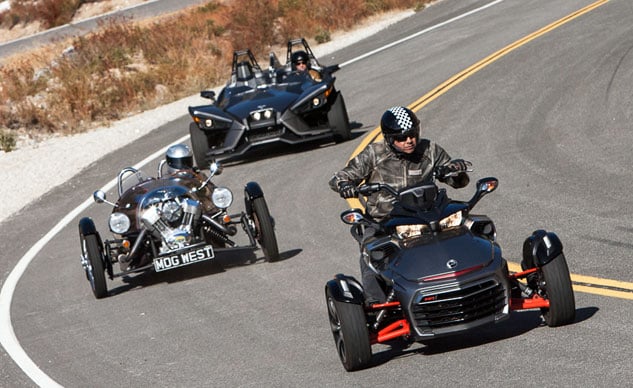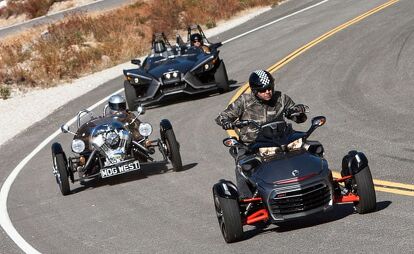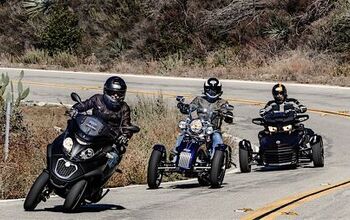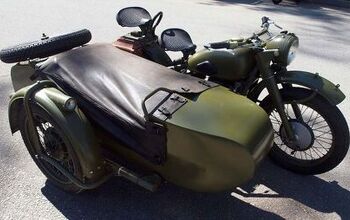Polaris Slingshot Vs. Can-Am Spyder F3-S Vs. Morgan 3 Wheeler
Is This A Motorcycle Shootout?
Technically, and by that I mean according to the way in which the vehicles here are registered through the DMV (except Texas, but more on that later), each of these three-wheelers qualifies as a motorcycle. In California, at least, a motorcycle endorsement on your driver’s license to legally operate them is not required, and the two with seatbelts eschew the state’s helmet law. Still, without a more explicit category available and the law being what it is, “motorcycle” becomes the default label for this trio.
As a lover of all-things-motorcycle, with a broad motorcycling perspective, you’ll not find me disparaging anyone for constructing or owning one of these reverse trikes, a traditional trike, a sidecar or any other configuration of “motorcycle” no matter how thin the association. However, in a situation of forced attrition where my garage is bereft of Morgan 3 Wheelers, Polaris Slingshots and Can-Am Spyders you’ll always find a two-wheel motorcycle, but never the other way around. Hopefully, under no circumstances will I only have one motorcycle in the garage.
Discuss this at our Polaris Slingshot Forum.
With that said, the comparison test here technically and subjectively qualifies as a motorcycle shootout – more so for some than others, but we’ve made peace with the elephant in the room. So let’s get into what we’re all here for: How ridiculously fun these things are to ride and/or drive.
To get the ball rolling, Chief Editor, Kevin Duke, has a few observations for those thinking the Morgan or Slingshot may be a good replacement for their Honda Civic.
2015 Polaris Slingshot Review – First Ride/Drive + Video
“Don’t mistake these cyclecars for having car-like interior noise levels,” he says. “Not only is wind noise naturally part of the equation, but engine and driveline noise is also much more prevalent than in a normal car.”
It should also be noted that the Morgan and Polaris Slingshot, although car-like in appearance, are not endowed with the same safety standards (airbags, crumple zones, side-impact protection, etc.), installed in actual automobiles. So, any perceived safety benefit compared to a two-wheeler is minimal at best.
Duke also reminds us that “a three-wheeler results in at least one wheel hitting every bump in the road – no swerving between tire lanes as on a motorcycle, and no straddling a centralized bump as in a car.”
Funny how the most expensive vehicle here, the Morgan ($78,000 as tested), is also the one lacking any of the modern technological rider aids with which the other two are so equipped. “There’s a pureness in the driving experience, where you know every input you’re giving is being delivered to the vehicle and not given by a computer’s interpretation of your demands,” says Siahaan.
“The Morgan’s steering is beautifully communicative, well-weighted and provides delicate yet clear feedback,” says Editorial Director Sean Alexander. “The 3 Wheeler’s well-sorted chassis encourages the driver to explore its admittedly low limits, while its Mazda Miata-sourced transmission has delightfully short throws and a satisfying feel of engagement.”
The Morgan’s lack of modernity and direct-connect feel is in stark contrast to the Slingshot and its electronic package including ABS and stability- and traction-control systems.
“I was initially unhappy with the Slingshot’s handling balance until I switched off the stability control,” says Duke. “Once unbridled, the chassis balance between front and rear wheels became much more readable, upping the fun factor significantly.”
“The Slingshot is capable of negotiating a twisty mountain road quicker than the other two vehicles in this comparo,” says Alexander. “Bang-for-buck, it’s the one to choose. However, I find it less engaging and the least satisfying of the three to drive quickly.”
The Slingshot’s steering surprised us by its inability to self-center the front wheels, forcing a driver to be very assiduous to his steering inputs. We spoke to Polaris about the issue, and it claims this is the first instance they’ve ever heard of this happening. According to Polaris, the vehicle we tested was pre-production model, and in the time between it and the consumer models now available, the company has “improved fit-up between the power steering unit and steering rack. Both of these changes contribute to an improved steering feel for production units.”
And then there’s the Can-Am Spyder F3-S – arguably the best Spyder to date and the closest kin to a true motorcycle in this group. “The F3 doesn’t steer like a motorcycle, but its chassis feels playful to a rider – up to a point,” says Duke. “Push its front tires a little too hard into a corner, and the electronic stability control intervenes like a killjoy mother, unexpectedly clamping on its brakes to reduce speed. To extract maximum enjoyment in corners, a rider needs to approach, but not push past, the electronic nanny’s limits.” This was a sentiment echoed by all our testers.
While the F3’s algorithms are less intrusive than those of other Spyder models, an experienced rider will reach the F3’s electronic limitations in short order. A possible fix could be for Can-Am to introduce some adjustability into the system, allowing a rider to choose the level of electronic influence.
One thing that’s for certain, the Slingshot was an instant celebrity. We’re accustomed to the gravitational pull of Spyders on passersby, and the Morgan is certainly a head turner, but the Slingshot eclipsed them both. Even Alexander had to admit that the Slingshot draws a crowd. “During our testing the Slingshot seemed to render the Spyder almost invisible, causing crowds to gather and completely ignore our Spyder which was frequently parked right next to it.”
The view from the front is aggressive and stimulating, but moving to the side or rear of the Slingshot garnered mixed reactions from our group of editors as well as the general public. “Unlike Sean, I don’t even mind the side profile,” says Siahaan. “But the back … well … something has to be done back there. The rear looks like an afterthought.” Duke opined that the view from the rear looks like a chairlift with a wheel bolted on.
Compared to the Morgan, the Slingshot is also a far more practical vehicle. With cruise control, cup holders, a glove compartment, and lockable behind-the-seat storage compartments, the Slingshot is better equipped for performing mundane tasks than either the Morgan or Spyder. With its lockable front storage compartment (6.5 gal) the minimalist Spyder actually has more stowage space than the aluminum-bodied Morgan.
2015 Harley-Davidson Freewheeler Review
All testers approved of the Mazda Miata 5-speed gearbox in the Morgan, calling it an “absolute delight,” among other praise-worthy quotes. The Slingshot’s drivetrain, on the other hand, was said by Duke to “howl at various speeds and gears.” Alexander summed it up as an “economy car powertrain that feels and sounds like an economy car powertrain.”
The Spyder’s foot shifter and handlebar-mounted clutch lever, while the most familiar to us, requires a muscled pull to operate the clutch, and its gear selection was, at times, notchy. Spyder buyers can upgrade to the SE5 semi-automatic transmission for $1,500. At the F3’s launch, I rode mostly with the SE5 transmission and consider its push-button operation worth the price of admission.
When it came to braking on the Spyder, Alexander explained it thusly: “Combined brakes leave a lever-free right grip that takes some getting used to, especially when trying to stop quickly. Using the right pedal for performance braking feels sort of like a lingering kiss from a close relative. It’s just unnatural.”
Also operated by a foot pedal, but at the other extreme of linked brakes, are the manually operated ones of the Morgan. “Non-power brakes require a strong stomp but offer pure feedback during threshold braking,” says Duke. The Slingshot’s brakes provide powerful, progressive stopping performance in all situations.
In the price department we’ve a wide gap between the Slingshot ($20k), Spyder ($21k as tested, $19.5k for the base model F3) and the Morgan at $78k as tested. Base model Morgans are priced somewhere in the $40k to $50k range, but that’s still twice as expensive as the other vehicles in this comparison. Granted, our tester came with a host of aesthetic factory options, like the $3,796.47 Factory Bright Pack, which boasts chrome roll bars, polished exhaust, polished lower engine case, and chrome headlight buckets.
Once our tester arrived in the States, Morgan West, the dealer who lent us their demo, tacked on the “Morgan West Queen’s Diamond Jubilee Package,” which adds even more chrome/polished bits, graphics, and a Raptor air intake for the X-Wedge engine. Cost? Try $12,660.63. Needless to say, when it comes to the Morgan, if you have to ask, you probably can’t afford it. Which leaves us with the Slingshot and Spyder.
Due to the apples vs dinosaurs nature of this comparo, we disposed of our normal scoring system because it just didn’t seem appropriate. However, there was consensus among all editors that when it comes to best bang for the buck, it’s almost impossible to beat the new Slingshot. At only $19,999 for the base model and $23,999 for the upgraded SL version (larger 18- and 20-inch, front and rear, forged aluminum rims, media console with a 4.3-inch LCD screen with a rearward camera, USB input and Bluetooth integration, and a six-speaker audio system), there’s not much, if anything, that can compete with the Slingshot in terms of fun, performance and wow factor at those prices.
Before you begin typing in the Comments section below your chastisement of us for not including the T-REX in this comparo, know that we did, in fact, contact Campagna Motors but our requests fell on deaf ears. However, the lowest priced T-REX model, the V13R, costs $54k, putting it in a price range similar to the Morgan. The MSRP of the T-REX leaves the $20k Slingshot looking like a better bang-for-buck proposition.
Polaris is currently battling Texas and that state’s asinine decision to disallow Slingshots to be registered as motorcycles. Asinine because the Morgan, Spyder and T-REX have already established precedent to the contrary. “We are working on it as a top priority but as of now the status has not changed,” says Polaris. Stay tuned to MO’s “What’s New” section for updates regarding this situation.
+ Highs
- Best Spyder yet
- New Triple much better than old Twin
- Customizable seating position
– Sighs
- Expensive, especially when compared to Slingshot
- Electrical nannies still too intrusive
- Bummer about the reduced storage capacity
+ Highs
- Coolest vehicle here by a wide margin
- Handmade
- Fun going fast or slow
– Sighs
- Most impractical vehicle here by a wide margin
- OMG! How much?
- Bereft of lockable storage
+ Highs
- OMG! How much?
- Front styling
- Everyday usability
– Sighs
- Plastic-y, low-rent feel
- Rear styling
- Keyed ignition is only security measure
Is This A Motorcycle? Reverse Trike Specs | |||
| Can-Am Spyder F3 | Morgan 3 Wheeler | Polaris Slingshot | |
| MSRP | $19,499 / $20,999 | $52,000 ($78,000 as tested) | $19,999 / $23,999 |
| Engine Capacity | 1330cc | 1983cc | 2384cc |
| Engine Type | Rotax ACE, DOHC, liquid-cooled, inline-Tripe | S&S, pushrod, 4-valve, air-cooled, V-Twin | GM, Ecotec, DOHC, liquid-cooled, inline-Four |
| Claimed HP | 115 @ 7250 rpm | 93 @ 5250 rpm | 173 @ 6200 rpm |
| Claimed Torque | 96 lb-ft @ 5000 rpm | 103.3 lb-ft at 3250 rpm | 166 lb-ft @ 4700 rpm |
| Bore x Stroke | 84.0mm x 80.0mm | 104.8mm x 111.1mm | 88.0mm x 98.0mm |
| Compression | 12.0:1 | 9.75:1 | 10.4:1 |
| Fuel System | EFI | EFI | EFI |
| Transmission | 6-speed manual or semi-automatic with reverse | Mazda 5-speed with reverse | 5-speed manual with reverse |
| Final Drive | Belt | Belt | Belt |
| Frame | Tubular steel | Tubular steel space frame | High-strength tubular steel |
| Front Suspension | Double A-arm with anti-roll bar | Unequal-length A-arm | Double-wishbone with anti-roll bar |
| Rear Suspension | Monoshock swingarm | Monoshock swingarm | Monoshock, single-side swingarm |
| Front Brakes | Twin 270mm discs, radially mounted Brembo monobloc four-piston calipers | Twin 280mm vented discs, radially mounted four-piston calipers | Twin, 298mm vented discs |
| Rear Brakes | 270mm disc, 1-piston floating caliper with integrated parking brake | 250mm drum | Single, vented 298mm disc |
| Front Tire | 165/55-15 | 4.00 x 19 | 205/50-17 / 225/45-18 |
| Rear Tire | 225/50-15 | 175/55-16 | 265/35/18 / 255/35-20 |
| Seat Height | 26.6 inches | NA | NA |
| Wheelbase | 67.3 inches | 92.0 inches | 105.0 inches |
| Curb Weight | 850 (dry weight) | 1212 lbs | 1725 lbs / 1745 lbs |
| Fuel Capacity | 7.1 gal | 11 gal | 9.77 gal |
A former Motorcycle.com staffer who has gone on to greener pastures, Tom Roderick still can't get the motorcycle bug out of his system. And honestly, we still miss having him around. Tom is now a regular freelance writer and tester for Motorcycle.com when his schedule allows, and his experience, riding ability, writing talent, and quick wit are still a joy to have – even if we don't get to experience it as much as we used to.
More by Tom Roderick
















































































































Comments
Join the conversation
I'll just bet the Slingshot generates an aftermarket industry in steering/brakes upgrades, and can't wait for the first turbo'd version.
Whoa, Nellie!
No doubt these are fun powersports VEHICLES but they are not motorcycles - they don't lean